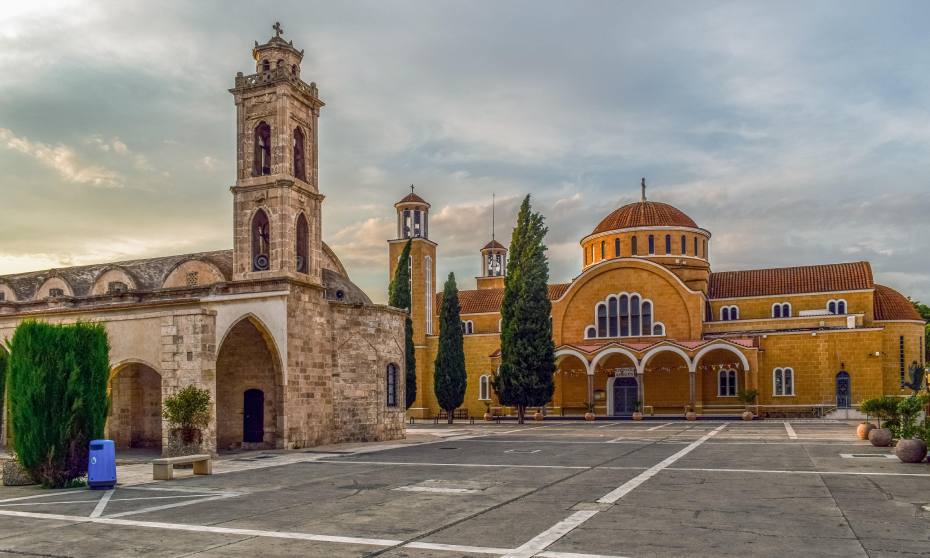PARALIMNI – PROTARAS
Saint George Old Church
It is located in the square in the center of Paralimni. A marble inscription reveals that the current church was “erected from the ground up” in 1859, on the site of an older Byzantine church from which parts were saved and incorporated into the newer one. The fresco of Ayios Georgios Drakontoktonos fills the entire drum of the blind arch on the north wall and the icons date back to the 19th century. The wood-carved iconostasis was created in 1869 by wood-carver Paraskevas Alagiotis.

Saint George Old Church
Prophet Elias
On a steep cliff, a few metres away from the heart of Protaras, is this stone-built, Byzantine-style chapel. In order to visit it, you have to climb 153 steps, but the view once at the top is definetly worth it. The chapel is visible from all over the area, especially at night when it’s lit up.

Prophet Elias
Panayiotissa
This chapel dedicated to the Virgin Mary, was built at the beginning of the 20th century and has been completely renovated this year. While restoration works were carried out, antiquities of the Hellenistic period came to light that refer to the last king of Salamis, Nicocreon, and the reign of emperor Heraclitus, as well as the foundations of an ancient basilica dating back to the 6th century AD. The bones of Father Zacharias, who, according to tradition, was martyred by the Ottomans in the late 17th century, were also found. The Church is dedicated to the Assumption of Virgin Mary and was built on the ruins of an older church and settlement that were destroyed during the Turkish occupation. During the renovation works, a small house was built right next to the church and a space for various animals and birds, such as turtles and peacocks, was created. The church is located on Panayias Street, 300 metres away from Protaras Avenue.
Ayioi Anargyroi
Near Cape Greco is this picturesque chapel dedicated to the Anargyros Saints – Kosmas and Damianos – which was built in the 1950s. The tradition starts from a cave that is located nearby and it is believed that the Anargyros Saints practiced asceticism in it. The view towards the sea makes the location magnificent while at sunset you will enjoy one of the most beautiful views.

Ayioi Anargyroi
Ayia Triada
In a picturesque cove, 3 kilometres away from Paralimni and next to the homonymous fishing shelter, is this small blue and white chapel. Its interior consists of a simple iconostasis with a few icons. The fishermen of the area, along with passers-by, always keep the candles in front of the icons lit.
AYIA NAPA
Medieval Monastery of Ayia Napa
The stone-built religious monument is located on Ayia Napa Square and is one of the most important historical sites in the area. The underground finds testify to the existence of a Christian community from the 11th century, but the first part of the temple was built during the Frankish occupation (13th-14th century). The entire monastery – which now functions as a museum – was completed in the 15th century. The name Ayia Napa is estimated to have been given before 1366, when, according to tradition, the miraculous image of the Virgin Mary was found in a cave by a hunter. The hunter’s dog was the one who found the opening of the cave and as he entered he started barking persistently. The hunter went to look for him in the cave, and discovered the icon that gave its name to the Monastery and the entire village. Address: Ayia Napa Square. Tel: +357 23 722 584 & +357 99 274 036. Working Hours: Daily 9.30-21.00

Medieval Monastery of Ayia Napa
Ancient Tombs of Makronissos
The necropolis of Makronissos consists of 19 carved tombs, a small sanctuary and an ancient quarry. The monument, as evidenced by the bounties found during the excavations, dates back to the Hellenistic and Roman periods. The necropolis is an indication of the existence of an ancient settlement in the area and is an important source of information about Greek burial customs of the time. The dead were placed in clay sarcophagi that were originally covered with three flat tiles. Today, one of the surviving clay sarcophagi, along with some of the bounties are on display at the Thalassa Municipal Museum in Ayia Napa. Address: Makronissos, west Ayia Napa. Tel: +357 23 816 300. Working Hours: Open Daily 9.00-17.00.

Ancient Tombs of Makronissos
Aqueduct Archaeological Site
The ancient Aqueduct dates back from the first Roman period and was originally restored by the Franks at the time when the Medieval Monastery was built. It was in use until the end of the 19th century, until the Department of Antiquities undertook its maintenance and restoration. The water of the spring ends at the Monastery, where after passing under the so-called ‘Private House’ inside the Monastery, it gushes through a cephalopod fountain represented by a marble head of a wild boar. • Paleontological Cave The first palaeontological excavations in the cave of Ayia Napa started in 2000 and have revealed important information about the endemic mammals of Cyprus, the dwarf hippos (Phanourios minor) and elephants (Eiephas Cypriotes)
DERYNEIA
Church of Ayia Marina
A very important monument of Byzantine heritage, it’s probable that it was built in the 12th century. It is a Byzantine building with a dome and consists of two connected churches of the same size that communicate with passages. It is isolated in the fields about three kilometres east of Deryneia in a small valley that was once overgrown and looked like a small paradise. Today it is silenced, found in the Buffer Zone which is controlled by the United Nations. On the day of the feast of the Saint, on July 17, every year, the faithful, accompanied by a United Nations military guard, go there to attend the Divine Liturgy and pray
Church of the Nativity of the Virgin (Geniseos tis Theotokou)
The old church dedicated to the Virgin Mary is located in the centre of Deryneia and is of great architectural interest. Its construction is dated back to the late 15th or early 16th century. As the population increased, it was expanded with two new callers. A plaque on the wall states that the work was completed in January 1727. Inside, the church is adorned with a beautiful carved wooden iconostasis dating back to 1911. It houses 18th century icons, perhaps even older.

Church of the Nativity of the Virgin (Geniseos tis Theotokou)
Chapel of Ayios Georgios (Saint George)
In the central square of Deryneia stands the old chapel of a Byzantine style, which dates from the 15th to the 16th century. Inside you will see a magnificent wood-carved gilded iconostasis built in the 16th century. A large mural also depicts St. George on horseback, framed by small icons from his martyrdom. The western part of the temple is an addition, which is unknown when it was made.
SOTIRA
Church of the Transfiguration of the Saviour
Due to recent excavations that show that the church was built on a larger early Christian church of the 4th to 5th century, this is one of the most important monuments in the area. The current form of the church, a single-aisled vaulted roof with a dome, is the result of repairs made in the 16th century. Its frescoes date back from the 13th century and its bell tower, with rich stone carvings, dates back to the 19th century.
Chapel of Ayios Mamas
This beautiful chapel of the 16th century is a single-aisled church with a dome of the FrancoByzantine type. It was decorated with frescoes of the same period, most of which have unfortunately been destroyed. However, three important despotic icons survived: of Christ, of the Virgin Mary and of Saint Mamas of 1754, works of the School of Painting of the monastery of Ayios Iraklidios.

Chapel of Ayios Mamas
Ayios Georgios of Chortakia
The church is cruciform with a dome and was built in the early 12th century. Unfortunately, only few of its murals have survived. At the time it was built, there was the settlement of Chortakia, whose inhabitants had taken refuge in Sotira after pirate raids on the coastline.

Ayios Georgios of Chortakia
Panayia Chordakiotissa
The church and the monastery date back from the end of the 12th century. However, nowadays, only the monastery’s ledger, some cells and well survive. The church is single-aisled with a dome and was decorated with frescoes of which only a few traces remain, such as the Virgin in a prayer type. Two icons come from the church; that of the Christ and Panayia Odegetrias of the 16th century and of Panayia Chordakiotissa of 1853, works of the school of Ioannis Kornaros from Crete. During periods of drought, the inhabitants made a procession with the icons that is considered to be a rainmaker.
Chapel of Ayia Thekla
Next to the sea is the small church of Ayia Thekla, where the ruins of an early Christian royal church was found with mosaics which have unfortunately been destroyed. Ayia Thekla, built at the beginning of the 20th century, functioned as a nunnery and many of its portable icons have been hagiographed in the occupied monastery of Apostolos Barnabas. On the Monday of the Holy Spirit, after the Divine Liturgy, the priest throws the cross into the sea for the swimmers to bring back. This beautiful small church is certainly worth a visit especially at sunset.

Chapel of Ayia Thekla
Catacomb of Ayia Thekla
West of Ayia Thekla there is an underground carved temple, probably an ancient tomb, which was transformed into a temple in the middle Byzantine period or during the years of Frankish rule, considering there is an engraved cross about the chapel. Abbot Yiorgos Ioannou will guide you to these wonderful Byzantine treasures Tel: +357 99 567 463.


